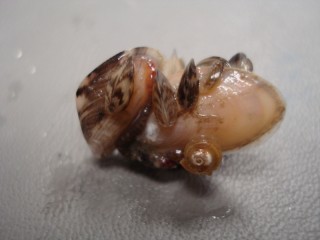Zebra, Quagga Mussels Trump Pollution as Change Agents in Lake Erie

SUNY Buffalo State Quagga and zebra mussels.
That community—creatures living on, near, or below the bottom of the lake—is “fundamentally changed from its past,” according to a paper published online in the current journal of the Journal of Great Lakes Research. Lyubov Burlakova, who works with the Great Lakes Center at SUNY Buffalo State, is the first author. The coauthors are Alexander Y. Karatayev, director of the center; Christopher Pennuto, a research associate with the center and biology professor at Buffalo State; and Christine Mayer, associate professor of ecology at the University of Toledo.
“The story of Lake Erie shows how profoundly human activity can affect an ecosystem,” said Burlakova. She traces that activity as far back as the early 1800s, when people cut down forests and built sawmills and dams. In 1918, the first report documenting the deterioration of water quality was published by the International Joint Commission.
The number of people living in the Great Lakes basin grew dramatically throughout the first half of the twentieth century. By the 1950s, a declining mayfly population in the western basin of Lake Erie indicated widespread anthropogenic eutrophication (human activities resulting in more nutrients such as phosphorous in the water, leading in turn to decreased oxygen levels). As a result, the benthos population became dominated by species that could survive with much lower oxygen levels throughout the 1960s.
The Great Lakes Water Quality Agreement of 1972 was signed by Canada and the United States. The authors report that subsequently the agreement, which introduced bans on the sale of phosphate detergents, improvements in waste water collection and treatment systems, and reductions in industry discharges, did indeed help to improve water quality. The benthic species that were dominant during the time of the most severe pollution declined as the pollution, especially phosphorus, abated.
However, in 1986, Dreissena polymorpha, the zebra mussel, was detected in Lake Erie, followed in 1989 by Dreissena rostriformis, the quagga mussel. “The zebra and quagga mussels are ecosystem engineers,” said Burlakova. Both are filter feeders that were brought to the Great Lakes by transoceanic shipping, and they out-compete native filter feeders, which then decrease in abundance.
After analyzing historical data on benthic community composition in Lake Erie over the last 50 years, the authors conclude that the lake’s benthic community has changed significantly, even after taking into account the challenges presented by differences in sampling design, gear and preservation techniques, and taxonomic resolution over the years.
Although both zebra and quagga mussel populations have most likely peaked—the zebra mussel around 1989 and the quagga mussel between 1998 and 2002—another invader, the round goby, has been preying on selected benthic groups, continuing to affect the composition of the community. However, the impact of the Dreissena invasion appears to have had a larger effect on the benthic community than all the other changes over the last five decades.
Media Contact
More Information:
http://www.buffalostate.eduAll latest news from the category: Ecology, The Environment and Conservation
This complex theme deals primarily with interactions between organisms and the environmental factors that impact them, but to a greater extent between individual inanimate environmental factors.
innovations-report offers informative reports and articles on topics such as climate protection, landscape conservation, ecological systems, wildlife and nature parks and ecosystem efficiency and balance.
Newest articles

Long-sought structure of powerful anticancer natural product
…solved by integrated approach. A collaborative effort by the research groups of Professor Haruhiko Fuwa from Chuo University and Professor Masashi Tsuda from Kochi University has culminated in the structure…

Making a difference: Efficient water harvesting from air possible
Copolymer solution uses water-loving differential to induce desorption at lower temperatures. Harvesting water from the air and decreasing humidity are crucial to realizing a more comfortable life for humanity. Water-adsorption…

In major materials breakthrough
UVA team solves a nearly 200-year-old challenge in polymers. UVA researchers defy materials science rules with molecules that release stored length to decouple stiffness and stretchability. Researchers at the University…



